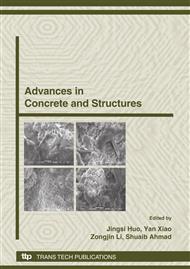p.145
p.151
p.157
p.163
p.169
p.175
p.181
p.187
p.195
Effect of Calcination Temperature on the Microstructure, Activity and Expansion of Mgo-Type Expansive Additive Used in Cement-Based Materials
Abstract:
Shrinkage compensating by the expansion generated by the hydration of expansive additive is one of the important measures to improve the dimensional stability of cement-based materials. Due to the slow hydration of MgO, it may cause delayed expansion in cement and thus has been used as an expansive additive to compensate thermal shrinkage at late age in mass concrete. The relationship among the microstructure, activity and expansion properties of MgO-type expansive additive (MEA) has not been clearly demonstrated, though many researches have been focused on its expansion mechanism and expansion properties. So the industrial production and application of MEA depend much on empirical methods. Three different types of MEA are produced by calcining magnesite at 900°C, 1100°C, and 1300 °Cfor 1h in an electrical furnace. The specific surface area, activity, inner pore structure, microtopography and expansion properties of the MEA have been investigated. Results show the effect of calcination temperatures on the expansion properties of MEA results from the changes in its microstructure, specific area, and thus the activity. High calcination temperature causes growth in MgO grain, decrease in specific area and surface defects of MgO, and hence the reduction of the activity value, inducing slow hydration rate and thus delayed expansion. This study will provide a platform for well understanding various activity and expansion properties of MEA produced under different temperatures.
Info:
Periodical:
Pages:
169-174
Citation:
Online since:
October 2008
Authors:
Price:
Сopyright:
© 2009 Trans Tech Publications Ltd. All Rights Reserved
Share:
Citation:


